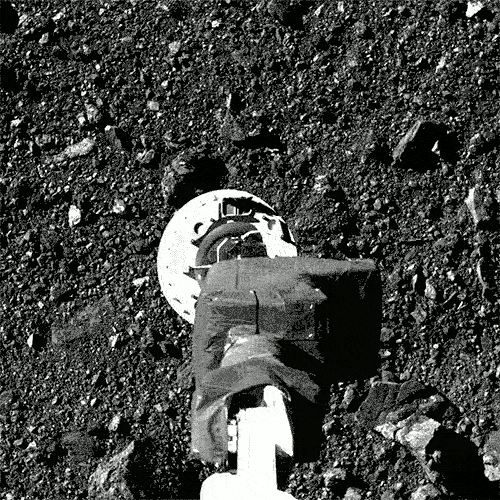Watch the exact moment a NASA spacecraft 'tags' an asteroid
In the end, it was more of a punch than a high five.
NASA's OSIRIS-REx spacecraft touched down briefly on an asteroid Tuesday, gathering samples of the space rock that will be delivered to Earth in 2023. The intricate maneuver, conducted more than 200 million miles from Earth, was the first time NASA has collected pieces of an asteroid in space.
On Wednesday, the agency released new video of the spacecraft's cosmic encounter with the asteroid, named Bennu. The images, which were taken by a camera aboard OSIRIS-REx, show the final moments of the spacecraft's descent.
As the probe approached Bennu's rocky surface, it extended an 11-foot-long robotic arm equipped with a round collection plate on the end. After OSIRIS-REx made contact with the asteroid, it fired a nitrogen gas canister to kick up debris into the collection plate.

The newly released video shows the moment that OSIRIS-REx thumped the asteroid's surface, throwing dust and rubble up into the camera's field of view.
"You can see that particles are flying all over the place," Dante Lauretta, the principal investigator for the OSIRIS-REx mission, said Wednesday in a news briefing. "We really did kind of make a mess on the surface of this asteroid, but it's a good mess. It's the kind of mess we were hoping for."
Although it took several hours for the spacecraft to reach the asteroid's surface, the encounter itself was very brief. Preliminary results show that OSIRIS-REx touched Bennu's surface for only about 6 seconds before it fired its thrusters to back away, NASA said.
It's not yet known how much material was collected, but mission scientists will perform a series of maneuvers to measure whether there has been a change in mass in the robotic arm's collection plate. That will help the researchers confirm that samples of Bennu were successfully obtained. Mission operators have said they hope to gather at least 2 ounces of material.
The van-size spacecraft, which launched in 2016, will begin its three-year journey back to Earth — delivering the asteroid samples in September 2023.
Only one other space agency, the Japan Aerospace Exploration Agency, has successfully collected samples from an asteroid in space. Japan's Hayabusa mission delivered a small asteroid sample to Earth in 2010, and a follow-up mission, dubbed Hayabusa2, is scheduled to return to Earth in December with samples from a different asteroid.
Scientists have said studying materials from asteroids could reveal insights into how the solar system formed about 4.5 billion years ago. The pristine nature of these space rocks, which are remnants from the earliest days of the solar system, could give researchers a better understanding of the origins of life on Earth.
"OSIRIS-REx, in my opinion, is the culmination of human activity as a species. We built this mission for peaceful purposes, out of curiosity and our desire for knowledge," Lauretta said.
